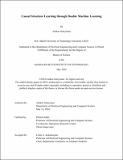Causal Structure Learning through Double Machine Learning
Author(s)
Soleymani, Ashkan
DownloadThesis PDF (6.462Mb)
Advisor
Jaillet, Patrick
Terms of use
Metadata
Show full item recordAbstract
Learning the causal structure of a system solely from observational data is a fundamental yet intricate task with numerous applications across various fields, including economics, earth sciences, biology, and medicine. This task is challenging due to several reasons: i) observational data alone, as opposed to interventional data, do not characterize the properties of the system under interventions on variables; therefore, it contains information on correlation instead of cause-effect one, ii) unobserved confounders may induce biases for the algorithms, leading to false causal inferences instead of revealing the correct causal structure, like a hidden common confounder, iii) the number of potential underlying structures increases super-exponentially with the number of variables, posing significant statistical and computational challenges and iv) the identifiability problem arises because multiple causal models can yield the same observational distribution, making it impossible to conclusively determine the true structure. In this thesis, we focus on the partial identification of underlying p causal structure from observational data under minimal assumptions necessary for causal identification. To this end, inspired by Debiasd/Double machine learning machinery, we introduce efficient practical doubly robust algorithms enjoying fast √n-semiparametric convergence rate for three different tasks: (1) Finding the direct causes of the target variable under cyclic and unseen confounded high dimensional data with nonlinear structures, (2) Testing Granger causality and therefore causal structure identification from temporal data, and (3) Estimation of counterfactual prediction function in generalized nonlinear Instrumental Variables regression problem. As a natural use case, we tackle the offline policy evaluation of the confounded contextual bandit problem, when actions, contexts, and rewards have common unobserved confounding. By matching the upper bounds with the unconfounded contextual bandit settings, our algorithm is proven to achieve optimal sample complexity.
Date issued
2024-05Department
Massachusetts Institute of Technology. Department of Electrical Engineering and Computer SciencePublisher
Massachusetts Institute of Technology